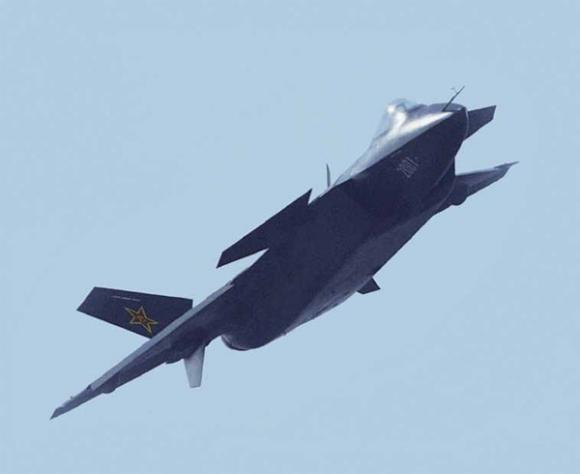The Chinese fifth-generation fighter Chengdu J-20 will achieve its initial operational capacity within the 2018. The Chengdu J-20 will probably play the role of long-range aerial supremacy in every area of the western Pacific region.
This is what has been titled this morning on the major Chinese newspapers.
The Shenyang J-31 "Falcon Hawk", on the other hand, should be the ideal platform in the "anti-access area-denial" strategy (A2AD) in the Western Pacific.
Fifth-generation Chinese fighters
The J-31 has always been considered the cheap alternative to the F-35 and is expected to be adopted in the future also by the allies of China and by those who cannot buy the "original" JSF. J-20 and J-31 fighters under development in China demonstrate the high potential of Chinese aviation technology.
The Shenyang J-31, (mostly for propaganda), is called a fifth generation fighter, even if for the West it is considered fourth. The fighter has similarities with the Russian PAK-FA T-50, although it would be more correct to say that the design of the J-31 resembles that of the F-35. The Shenyang J-31 "Falcon Hawk" flew the 31 October 2012 for the first time. Designed (probably) thanks to a reverse engineering process by a downed American stealth fighter, it should have become the fifth generation Chinese fighter on board, effectively becoming the F-35 Lightning II antagonist. But something does not seem to have worked.
China, which has only one aircraft carrier, has reduced the real value of the aircraft, proposing it to second-level air forces such as Brazil, Pakistan and some Middle Eastern countries. It seems that the technology created was not initially designed for export, but built for internal use. Strangely, last year the Chinese press also lashed at the aircraft, claiming that the plane would not be able to take off from an aircraft carrier with heavy armament.
By analyzing the photos, the J-31 seems to be little more than a cheap copy of an American fighter jet. In fact, the nose section, the twin tails as well as the trapezoidal wings represent the distinctive lines of western stealth design. Probably, the J-31 is based on technology extracted from American planes lost in battle, like the F-117 stealth shot down in 1999, in Serbia.
It is also true that in recent years, targeted attacks have been made against Lockeed Martin. Therefore, Chinese hackers could have managed to get their hands on some useful technical drawings of the Raptor and the F-35. But it is also true that to copy American technology not only projects are needed. We must also be able to turn them into reality. However, to date it is impossible to compare the J-31 with other combat aircraft, given the secrecy that still surrounds it.
We know that his shooting control radar, as well as subsystems and avionics are entirely Chinese. His design certainly makes it look like a fifth-generation fighter, but we don't know the materials used for the aircraft's upholstery. The Chengdu J-20 project, a fifth-generation fighter that took off for the first time in January of the 2011 and defined by the Pentagon as "a long-range platform capable of penetrating heavily defended environments", appears much more serious.
According to the Chinese it could enter service with Initial Operating Capacity within the 2018 "with similar performance to the F-22 but with the operating costs of the F-35".
Even for this aircraft, references are wasted. According to the Russian press, the J-20 would present similarities to the MiG 1.44 technology demonstrator (in turn the latter reminds the EFA-2000). For the West, Chengdu J-20 is inspired by the fantastic Northrop YF-23, the only prototype proposed together with the YF-22 for the Advanced Tactical Fighter project.
For Chengdu J-20 at least six variants are foreseen: long-range interceptor, dogfigth and escort, ground attack, long-range reconnaissance, electronic attack and launch pad for anti-satellite missiles. The J-20 is also currently equipped with two Russian-made turbojets, although the line fighter should be equipped with a conception engine and national production.
The problem of the violation of copyrights on Russian weapons worries and not a little Moscow, even if both sides are trying to solve the problem. Down in the 2008, as part of the technical-military cooperation between the two nations, an agreement had been signed on the protection of intellectual property.
Drawing ideas and projects from other countries, however, seems to be a common practice for the Chinese. Suffice it to say that the same concept of having two stealth fighters for different types of missions is the same as in the United States: F-22 / J-20 for air supremacy (domain) and F-35 / J-31 for bombardment, Close Air Support and tactical support.
In 1992, China bought some Su-27SKs from Russia and then presented, fifteen years later, the J-11B, a shamelessly identical version of the Russian supercaccia. But the copies do not end there. According to the Russians, China, in violation of intellectual property agreements, would have cloned the Su-33 project, the S-300 air defense system, the drawings of the most powerful artillery rocket launcher in the world, the BM-30 Smerch and the specifications of the 152 mm 2S19 Msta self-propelled howitzer.












